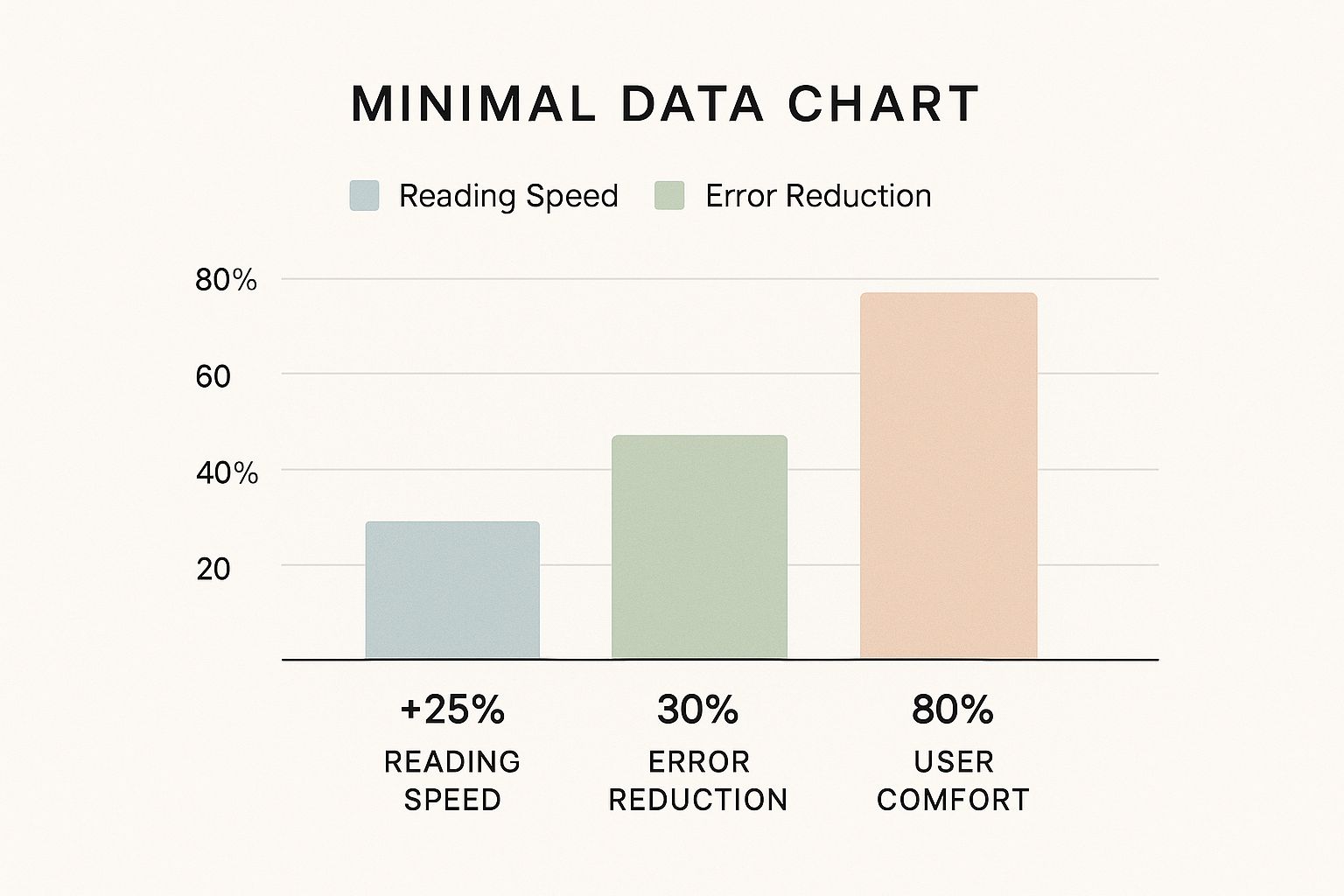Colored Overlays for Dyslexia: Do They Really Help Reading?

You’ve probably seen them before—those colorful, see-through plastic sheets. So, what are they all about?
Colored overlays are simply transparent sheets tinted with a specific color. The idea is to place one over a page of text to make reading easier for some people, particularly those who experience something called "visual stress."
This isn't just about disliking bright lights. For some readers, words on a page can seem to shimmer, move, or blur. The intense contrast between black text and a stark white background can feel overwhelming and uncomfortable.
How Do They Actually Work?
Think about wearing sunglasses on a brilliantly sunny day. They cut the glare and make it easier to see comfortably. Colored overlays operate on a similar principle, but for the printed page. They act as a filter, softening the harsh contrast and, for some, making the text look more stable and settled.
These simple, low-tech tools are often linked to a condition known as Irlen Syndrome, or scotopic sensitivity. People with this sensitivity report that the right color overlay can calm the visual chaos, making words stay still and reducing eye strain. Finding the "right" color is usually a matter of trial and error, seeing which hue provides the most relief.
What Do They Claim to Do?
The thinking behind colored overlays is that they can help readers in a few key ways:
Cut down on glare: The tint can reduce the overwhelming brightness of a white page, making it less jarring to look at.
Make text feel more stable: For those who see words as blurry or wobbly, an overlay might help the text appear sharper and more static.
Improve reading comfort: By easing the visual strain, these tools can make reading a less tiring activity, which might help someone focus for longer.
It's a really important point, though: while many people feel more comfortable using them, the scientific community is still debating whether this comfort leads to real, measurable gains in reading speed or accuracy for people with dyslexia. It's crucial to keep this in mind and have realistic expectations.
The core idea is straightforward: change how the page looks to reduce visual stress. But the million-dollar question remains—does easing that stress actually improve a person's core reading skills?
While the concept is certainly appealing, it's wise to look beyond personal stories and consider what the evidence shows. For a more proven, science-backed way to support reading, technology offers powerful alternatives. Speak4Me, for instance, assists readers by turning text into speech, directly addressing comprehension challenges.
Ready for a tool that's proven to help with reading? Download Speak4Me free on iOS to have any text read aloud, turning reading struggles into simple listening. (Note: in-app purchases may apply).
The Science Behind Colored Overlays for Reading

Speak4Me – Person listening to audio on a phone, representing an alternative to colored overlays for dyslexia.
Whenever you're looking at a tool meant to help with dyslexia, it’s only natural to ask the most important question: does it actually work? When it comes to colored overlays, the answer isn’t a simple yes or no. In fact, it’s a hot topic of debate among scientists and reading specialists.
Many people who use them say they make reading feel more comfortable. But turning that feeling into hard proof of better reading skills is where things get tricky.
The main idea behind colored overlays is that they help reduce something called "visual stress," a kind of eye strain or discomfort some people feel when looking at text. The problem is, solid scientific studies haven't been able to consistently show that using these overlays actually improves reading ability for people with dyslexia.
How Researchers Measure Reading Improvement
To figure out if a tool like a colored overlay is effective, researchers need more than just a person's opinion. They need objective data. They rely on standard tests to see if there's any real, measurable change in a person's reading performance.
Here are a few of the things they measure:
Reading Speed: This is all about how quickly someone can read a text accurately. It's often counted in "words read correctly per minute."
Reading Accuracy: This looks at the number of mistakes made while reading, like skipping words, mispronouncing them, or swapping one word for another.
Reading Comprehension: After reading a passage, how well did the person understand it? This is usually checked with a quick quiz.
By using these clear benchmarks, scientists can compare someone's reading with and without an overlay. This helps them see if the tool makes a real difference or if it just feels like it does. It’s all about separating subjective comfort from objective skill improvement.
What the Evidence Says
So, when colored overlays are put under the microscope, how do they hold up? Honestly, the evidence supporting them is surprisingly weak.
A major study from 2015, for instance, looked at reading fluency in a big group of people, from young children to adults. The results were clear: colored overlays did not improve the number of words read correctly per minute. What’s more, some of the adult readers actually performed worse when using them. You can read more about these research findings here.
And this wasn't just a one-off result. Other studies and research reviews have reached very similar conclusions. They've found little to no real benefit for reading fluency in people with dyslexia.
The bottom line from research is that while colored overlays may reduce subjective visual discomfort for some, they are not a proven tool for improving reading skills like speed or accuracy.
This is exactly why it's so important to lean on strategies that have strong scientific evidence behind them. Instead of putting faith in a tool with questionable results, modern technology offers support that is far more reliable and effective.
For a science-backed alternative that directly helps with reading, an app like Speak4Me can bypass the visual part of reading altogether by letting users listen to the text instead. This approach directly supports comprehension and makes information accessible without relying on visual aids.
Ready to try an evidence-based tool? Download Speak4Me free on iOS to turn any text into clear audio and make reading accessible. (Note: in-app purchases may apply).
Understanding The Irlen Syndrome Connection

Speak4Me – A collection of colorful translucent sheets representing colored overlays for dyslexia.
If you’ve looked into colored overlays for dyslexia, you've probably come across the term Irlen Syndrome. It’s the main theory that props up the whole idea of using these colored filters, so it's worth digging into what it is and what the science says.
Irlen Syndrome, sometimes called Scotopic Sensitivity Syndrome, is described as a problem with how the brain processes visual information. This isn't a learning disability. That's a really important distinction to make. Dyslexia is a language-based difference that affects how the brain handles written words, which you can read more about in our guide on what is dyslexia. Irlen Syndrome, on the other hand, is said to be a visual processing issue.
The theory goes that this condition causes "visual stress," making words on a page look blurry, jumpy, or like they're shimmering. The proposed solution? Precisely tinted colored overlays or glasses that supposedly filter out the troublesome light waves, making the text clear and calm.
The Theory Versus The Evidence
Here's where things get tricky. The idea of a simple colored sheet solving complex reading problems is incredibly appealing, but it’s also a hot topic of debate among scientists and educators. The evidence just isn't there to back it up.
Let's look at one major study. Researchers took 61 kids with reading difficulties, and a certified diagnostician identified a whopping 77% of them as having Irlen Syndrome. The kids were then tested reading with their "prescribed" colored overlay, a random colored overlay, and no overlay at all.
The results? There was no immediate improvement in their reading speed or skill, regardless of which overlay they used.
While many people genuinely experience the symptoms of visual stress, research has not been able to tie them to one specific syndrome or prove that colored filters are an effective fix for reading difficulties.
Many of the symptoms described, like eye strain and discomfort, are very real. You can find some helpful tips for understanding and preventing eye strain that address the discomfort itself, without turning to a disputed therapy.
Ultimately, we have to separate feeling more comfortable from actually improving reading skills. A colored overlay might feel nice, but it's crucial to lean on strategies that are proven to work for the core challenges of dyslexia. Instead of relying on visual aids with shaky scientific support, using technology that directly assists with reading is a much better bet. An app like Speak4Me completely bypasses any visual processing issues by reading the words aloud.
So, Why Are Colored Overlays Still So Popular?
If the science isn't there, why do we still see colored overlays for dyslexia everywhere? It’s a classic case of perception versus reality, and it boils down to a few very human reasons. The biggest one? We’re all drawn to a simple solution for a complicated problem.
When you see someone you care about struggling to read, the idea that a simple, inexpensive piece of colored plastic could fix it is incredibly appealing. It’s a tangible action you can take right now. That feeling of being able to do something—anything—offers immediate hope, which is why these overlays are still fixtures in so many homes and classrooms.
Trust, Endorsements, and a Helping Hand
It’s not just about wishful thinking. The popularity of colored overlays gets a huge boost from endorsements, often from organizations people know and trust. Even without solid scientific backing, some charities and support groups continue to suggest them. This gives the tools a stamp of legitimacy that can feel more persuasive than a dense research paper.
For instance, a number of major dyslexia charities in the UK still list colored overlays as a potential support measure. For a parent or teacher desperately seeking help, that kind of recommendation from a trusted source can easily win out over dry, academic studies.
The powerful appeal of a simple, visible tool, combined with endorsements from trusted sources, creates an environment where colored overlays can flourish, regardless of what the science says.
This is exactly why you might hear conflicting advice about the best ways to support someone with dyslexia. It’s so important to look beyond what’s popular and dig into what the evidence actually shows.
The Big Tech Factor
Another major piece of the puzzle is how these features have been woven into the technology we use every day. When a giant like Microsoft builds colored backgrounds directly into its software, it sends a powerful message. It feels like a definitive seal of approval.
Take a look at Microsoft’s Immersive Reader. It’s an amazing tool, and right there among its features are options to change the background color.
Speak4Me – Microsoft's Immersive Reader, showing options for colored page backgrounds as an accessibility feature.
Seeing these options in software used by millions reinforces the idea that colored backgrounds are a proven, effective tool. But here’s the catch: mainstream acceptance doesn’t change the underlying research. For example, a 2023 eye-tracking study found that reading on a yellow background offered no significant improvement in reading speed for people with dyslexia when compared to a standard white background. You can read more about the study's findings on colored backgrounds for the full picture.
This really highlights how crucial it is to think critically about the tools we choose. A colored background might make a screen feel a little easier on the eyes, but it’s not a replacement for strategies that actively build reading skills.
If you’re looking for a solution that provides proven support, it makes more sense to turn to evidence-based technology. Instead of just changing how text looks, tools like the Speak4Me app directly tackle reading challenges by voicing the words aloud.
Ready to try a method that’s backed by results? Download Speak4Me free on iOS and discover for yourself how listening can transform the reading experience. (Note: in-app purchases may apply).
Effective, Science-Backed Alternatives for Dyslexia

Speak4Me – A person wearing headphones, highlighting the benefits of auditory learning with text-to-speech apps.
So, if colored overlays aren't the magic bullet, what actually works? It's time to shift our focus to proven, evidence-based strategies that genuinely help readers with dyslexia. The most effective support doesn't just change how text looks; it changes how a person accesses it.
This is where multimodal learning comes in—a powerful approach that uses more than one sense at a time. For dyslexia, this often means combining visual reading with listening. The undisputed champion in this area is text-to-speech (TTS) technology.
TTS technology tackles the core challenges of dyslexia head-on by simply reading text out loud. This method allows the reader to bypass the visual processing snags and absorb information through hearing. It’s not about making the words look different; it’s about delivering the content in a way the brain can more easily handle.
The Power of Listening
Ever struggled with a dense instruction manual, only to have it all click when someone explained it to you? That’s exactly what TTS does for any written text. It transforms a potential roadblock into a simple listening exercise.
This is where a tool like Speak4Me really shines. It's an excellent assistant that helps with reading difficulties by voicing any text aloud. Instead of trying to fix a visual problem that research shows isn't the root cause, it opens up a direct path to understanding.
By turning written words into audio, TTS technology removes the decoding barrier that so often causes reading fatigue and frustration. This frees up mental energy, allowing individuals to focus on what the text means, not just what the words are.
Beyond TTS, a whole world of assistive technology is available to support people with dyslexia. For a deeper dive into some of the most helpful modern tools, check out this guide to the best assistive technologies for dyslexia).
Comparing Dyslexia Support Strategies
This table shows how visual aids like overlays stack up against a well-researched tool like text-to-speech. The Speak4Me app is a great example of powerful TTS technology.
Strategy | Scientific Evidence | Primary Benefit | How It Helps |
|---|---|---|---|
Colored Overlays | Limited to none. Most studies show no significant improvement in reading ability. | Subjective visual comfort for some individuals. | Reduces perceived glare or visual stress, but doesn't address the core mechanics of reading. |
Text-to-Speech (TTS) | Strong. Widely supported by research to improve comprehension and reduce cognitive load. | Bypasses decoding challenges. | Reads text aloud, allowing the user to listen and understand content without struggling to read it. |
As you can see, the evidence points clearly in one direction.
A More Reliable Path to Success
Modern technology offers a far more dependable route to reading success because it's built on a solid foundation of research. Study after study confirms that multimodal approaches—like listening while following along with the text—boost comprehension, memory, and confidence.
This is why educators and specialists are increasingly recommending tools that bring auditory learning into the mix. To learn more about this powerful approach, you can explore our guide on how to improve reading comprehension with text-to-speech. Choosing the right tool isn't just about temporary relief; it's about building real skills and fostering long-term independence.
Integrating Technology for Better Reading Support
The best tech is the kind that slips right into your daily life without a fuss. While visual aids like colored overlays for dyslexia can certainly make the page look more comfortable, tools backed by solid science offer a more direct path to easier reading. Moving from knowing what works to figuring out how to make it work for you is where Speak4Me can help build true confidence and independence.
Think about a text-to-speech (TTS) app, like Speak4Me. This isn't just about changing how words look on a page; it’s about changing how you engage with them entirely. It can read long work reports aloud, help a student tackle a mountain of homework without visual fatigue, or even let you proofread your own writing by hearing it back. It’s an app that assists in countless ways.
Customizing Your Listening Experience
To really make this kind of technology sing, you need to make it your own. With Speak4Me, you can adjust the speaking rate to a speed that feels right for you—slower for dense, tricky material and faster for skimming an article. Another pro tip? Pop in some headphones. It’s a simple way to block out distractions and really tune into what you’re hearing.
This is what can happen when you add auditory support to your reading routine.

Speak4Me – Infographic showing stats about the benefits of text-to-speech for reading.
The numbers speak for themselves. With the right tech, people see real, measurable improvements. We're talking up to a 25% boost in reading speed, a 30% drop in errors, and an 80% improvement in overall comfort. This is why shifting from purely visual aids to auditory tools can completely reshape the reading experience. For a deeper dive, see how you can improve reading comprehension with text-to-speech.
The goal here isn’t to find a crutch. It’s about building a bridge to more independence and self-assurance in all your daily reading tasks.
And the support doesn't stop with TTS. New technologies are popping up all the time. Exploring different AI text enhancement tools can help make written content even clearer and more accessible before you even start reading.
A Few Common Questions About Dyslexia and Visual Aids
Let's tackle a few last questions that often come up. It's totally normal to still have questions about colored overlays for dyslexia and the whole idea of visual stress. Here are some quick, straightforward answers to clear things up.
Do Colored Overlays Cure Dyslexia?
In short, no. Colored overlays do not cure dyslexia. It’s important to remember that dyslexia is a language-based learning difference, not a problem with eyesight.
Overlays are designed to help with visual stress, which is a separate condition some people experience. The scientific proof that these overlays actually improve reading ability is pretty thin.
Are Colored Overlays the Same as Colored Lenses?
They work on a similar idea but are used differently. Overlays are just plastic sheets you lay on top of a page. Colored lenses, on the other hand, are built into glasses (you might have heard of Irlen lenses).
Both are meant to ease visual stress, but neither is a proven fix for the core reading challenges that come with dyslexia.
The most important thing to remember is to focus on strategies that tackle the root cause of the reading difficulty. While visual comfort matters, tools backed by solid evidence offer a much more reliable path to success.
So, What Should I Use Instead of Colored Overlays?
The best tools are the ones that directly help with the act of reading itself. Text-to-speech (TTS) technology is a fantastic and proven example.
TTS reads text out loud, which means you can skip the tricky part of decoding words and jump straight to understanding what you're reading. This approach actually helps with the real challenges of dyslexia, not just the visual symptoms some people feel.
Instead of just trying to make text look different, effective tools like the Speak4Me app help you access it differently. By using solutions like text-to-speech, you can build confidence and turn reading into a much less frustrating experience.
Ready for a reading support tool that's proven to help? Speak4Me can turn any text into clear, natural-sounding audio, making information more accessible.
Download Speak4Me free on iOS and discover how listening can transform your reading experience. (Note: in-app purchases may apply).
Speak4Me – Download on the App Store badge
Try Speak4Me for Free
